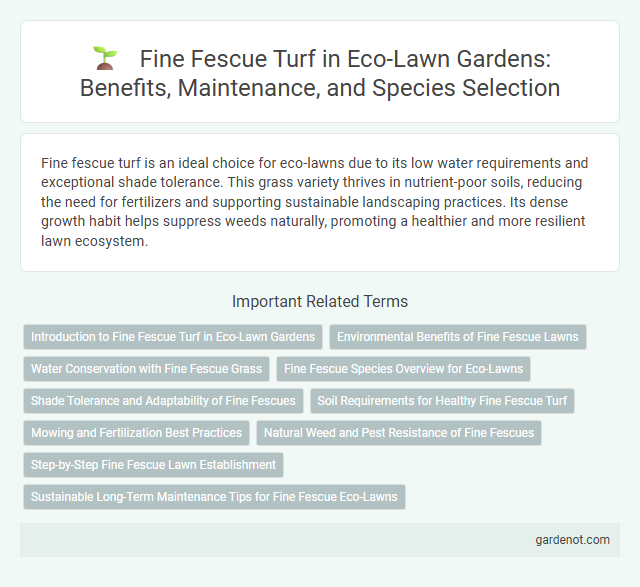Fine fescue turf is an ideal choice for eco-lawns due to its low water requirements and exceptional shade tolerance. This grass variety thrives in nutrient-poor soils, reducing the need for fertilizers and supporting sustainable landscaping practices. Its dense growth habit helps suppress weeds naturally, promoting a healthier and more resilient lawn ecosystem.
Introduction to Fine Fescue Turf in Eco-Lawn Gardens
Fine fescue turf, known for its shade tolerance and low maintenance requirements, is ideal for eco-lawn gardens aiming to conserve water and reduce chemical use. This grass species thrives in nutrient-poor soils, promoting sustainable landscaping by minimizing fertilizer needs. Fine fescue's dense growth habit supports soil health and limits weed invasion, enhancing biodiversity within eco-friendly lawn designs.
Environmental Benefits of Fine Fescue Lawns
Fine fescue turf promotes soil health by reducing erosion and improving water retention through its dense root system. Its low nutrient and water requirements result in decreased fertilizer runoff and water usage, contributing to sustainable lawn maintenance. Fine fescue lawns support biodiversity by providing habitat for beneficial insects and promoting pollinator activity.
Water Conservation with Fine Fescue Grass
Fine fescue turf is highly efficient in water conservation due to its deep root system and drought-resistant properties, requiring significantly less irrigation compared to traditional lawn grasses. This grass variety maintains its green appearance with minimal water input, reducing overall water usage by up to 50% in residential and commercial landscapes. Incorporating fine fescue into eco-lawn designs supports sustainable landscaping practices by promoting water efficiency and reducing the strain on local water resources.
Fine Fescue Species Overview for Eco-Lawns
Fine fescue species, including hard fescue, chewings fescue, sheep fescue, and creeping red fescue, are ideal for eco-lawns due to their drought tolerance, low nutrient requirements, and shade adaptability. These fine-textured grasses maintain a dense, low-maintenance turf that reduces the need for frequent mowing and irrigation, supporting sustainable lawn practices. Their deep root systems enhance soil stability and promote resilience against pests and diseases, making fine fescue a superior choice for environmentally friendly landscapes.
Shade Tolerance and Adaptability of Fine Fescues
Fine fescue turf excels in shade tolerance, thriving in low-light environments where many grass species struggle to establish. Its adaptability to diverse soil conditions and drought resistance makes it an ideal choice for eco-lawn applications in shaded landscapes. Fine fescues maintain a dense, fine-textured turf that supports sustainable, low-maintenance lawn solutions.
Soil Requirements for Healthy Fine Fescue Turf
Fine fescue turf thrives in well-drained, acidic to neutral soils with a pH range of 5.5 to 7.0, promoting optimal nutrient uptake and root development. Sandy loam or loam soils enriched with organic matter support moisture retention while preventing waterlogging, essential for fine fescue's drought tolerance and disease resistance. Regular soil testing and amendments to balance fertility levels ensure sustained turf vigor and resilience in eco-lawn applications.
Mowing and Fertilization Best Practices
Fine fescue turf thrives with mowing heights maintained between 2 to 3 inches to promote dense, healthy growth and reduce weed encroachment. Fertilization should be minimal, focusing on low-nitrogen formulas applied in early spring and late fall to support turf vigor without excessive growth. Adhering to these mowing and fertilization best practices enhances the sustainability and resilience of eco-lawn fine fescue turf.
Natural Weed and Pest Resistance of Fine Fescues
Fine fescue turf offers exceptional natural weed and pest resistance, reducing the need for chemical treatments and enhancing eco-friendly lawn care. Its dense growth habit and fine blades create an inhospitable environment for common lawn weeds and pests, promoting healthier turf ecosystems. This resilience makes fine fescue an ideal choice for sustainable, low-maintenance eco-lawns.
Step-by-Step Fine Fescue Lawn Establishment
Fine fescue turf establishes best in well-prepared soil with a pH between 5.5 and 7.0, requiring good drainage and moderate fertility. Begin by removing debris and tilling the soil to a depth of 4-6 inches, followed by precise seed sowing at a rate of 4-6 pounds per 1,000 square feet for dense coverage. Water consistently to keep the soil moist during germination, which typically occurs within 10-14 days, and mow once the grass reaches 3 inches to encourage healthy growth and weed suppression.
Sustainable Long-Term Maintenance Tips for Fine Fescue Eco-Lawns
Fine fescue turf thrives in eco-lawns due to its drought tolerance and low nutrient requirements, making it ideal for sustainable landscaping. Sustainable long-term maintenance includes mowing at a height of 2.5 to 3.5 inches to promote deep root growth, and reducing fertilizer applications by utilizing slow-release organic options that enhance soil health. Regular aeration and overseeding help maintain turf density and resilience, minimizing water usage and chemical inputs for eco-friendly lawn management.
Fine fescue turf Infographic

 gardenot.com
gardenot.com